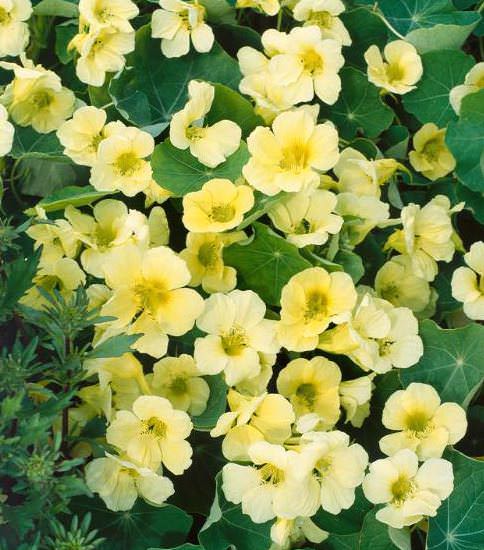Moonlight Nasturtium
Moonlight Nasturtium is not only a beautiful addition to any garden but also a useful one. With its unique trailing vines and bright yellow flowers highlighted in silver, this plant has been gaining popularity among gardeners in recent years. In this blog post, we will explore the benefits and uses of Moonlight Nasturtium and why you should consider growing it in your garden.
The Pain Points
Gardening can be a challenge, especially when it comes to choosing plants that can thrive in different weather conditions. If you have a garden in a hot climate, you know how challenging it can be to find plants that can tolerate the heat. Fortunately, Moonlight Nasturtium is one of those plants that thrive in hot weather. It is drought-resistant and can grow in poor, dry soil, making it a perfect choice for those with less fertile soil.
The Target of Moonlight Nasturtium
Moonlight Nasturtium's main target is to provide a shimmering radiance to your garden. It is perfect for borders, flower beds, hanging baskets, and even containers. This plant is ideal for adding a pop of color to your garden. Moonlight Nasturtium is also known for attracting pollinators, such as butterflies, bees, and hummingbirds, making it a great addition to any eco-friendly garden.
Benefits of Moonlight Nasturtium
Moonlight Nasturtium is not only aesthetically pleasing but also has many practical uses. The leaves and flowers of Moonlight Nasturtium are edible and have a peppery taste, similar to watercress. They can be added to salads, soups, sandwiches, and even used as a garnish. Due to the high vitamin C content, Moonlight Nasturtium has been used to treat scurvy in the past. Besides, this plant has antibacterial and antifungal properties and can be used as a natural remedy for coughs, colds, and flu.
My Personal Experience with Moonlight Nasturtium
As a passionate gardener, I love experimenting with new plants, and Moonlight Nasturtium has proven to be a delightful addition to my garden. Its unique silvery foliage and yellow flowers add a glow to my garden, and the fact that the leaves and flowers are edible makes it even more exciting for me. I have used the peppery leaves as a salad ingredient, and they have added a nice zing to my meals.
How to Grow Moonlight Nasturtium
Moonlight Nasturtium is easy to grow and maintain. It can grow in full sun to partial shade and needs well-drained soil. This plant does not need regular watering and can tolerate drought-like conditions, making it an ideal plant for busy gardeners. The plant is an annual that blooms throughout the summer and even into fall. To harvest the seeds, wait until the flowers fade, and the seed pods turn brown and dry. You can then collect the seeds and store them in a cool, dry place until the planting season.
The Antifungal Properties of Moonlight Nasturtium
Moonlight Nasturtium has antifungal properties which make it a useful plant for gardeners looking for natural ways to control fungi in their gardens. A fungicide can be made from the leaves and flowers by infusing them in boiling water and leaving for up to 24 hours. The resulting liquid can be used as a spray on plants to inhibit the growth of fungal diseases.
Using Moonlight Nasturtium as a Natural Insect Repellant
Another benefit of Moonlight Nasturtium is that it can repel insects naturally. This plant contains a compound called linalool, which is toxic to many common garden pests, such as aphids and whiteflies. Interplanting Moonlight Nasturtium with other plants in your garden can help deter pests from destroying your plants.
Frequently Asked Questions
Q: Is Moonlight Nasturtium an annual or a perennial plant?
A: Moonlight Nasturtium is an annual plant that blooms throughout the summer and into fall.
Q: Can I eat the flowers and leaves of Moonlight Nasturtium?
A: Yes, the flowers and leaves of Moonlight Nasturtium are edible. They have a peppery taste similar to watercress and can be used in salads, soups, sandwiches, and even used as a garnish.
Q: How do I harvest seeds from Moonlight Nasturtium?
A: Wait until the flowers fade, and the seed pods turn brown and dry. You can then collect the seeds and store them in a cool, dry place until the planting season.
Q: How can I use Moonlight Nasturtium as a natural insect repellant?
A: Moonlight Nasturtium contains linalool, a compound toxic to many common garden pests, such as aphids and whiteflies. Interplanting Moonlight Nasturtium with other plants in your garden can help deter pests from destroying your plants.
Conclusion
Moonlight Nasturtium is a versatile plant that can add beauty and functionality to any garden. This plant's unique silvery foliage and yellow flowers make it a perfect choice for borders, flower beds, hanging baskets, and even containers. It requires minimal maintenance and can tolerate drought-like conditions, making it ideal for busy gardeners. The fact that the leaves and flowers are edible and have antibacterial and antifungal properties makes it even more exciting to grow. Incorporating Moonlight Nasturtium into your garden can provide a glowing radiance, attract pollinators, and even help control fungal diseases and pests naturally.
Gallery
Eye Candy For The Famished: Yellow Climbing Nasturtiums

Photo Credit by: bing.com / climbing nasturtiums yellow nasturtium flowers famished candy eye
Nasturtium Seeds - 12 Nasturtiums - Showy Annual Flower Seeds

Photo Credit by: bing.com / nasturtium moonlight nasturtiums
MOONLIGHT Nasturtium Seeds This New Introduction Trails To 6 Feet And

Photo Credit by: bing.com / nasturtium moonlight flower annual seeds flowers yellow nasturtiums swallowtailgardenseeds
Nasturtium 'Moonlight' - Tropaeolum Majus Seeds - Select Seeds

Photo Credit by: bing.com / nasturtium moonlight majus tropaeolum
Nasturtium Seeds - Moonlight
Photo Credit by: bing.com / nasturtium seeds moonlight buy tropaeolum majus sold